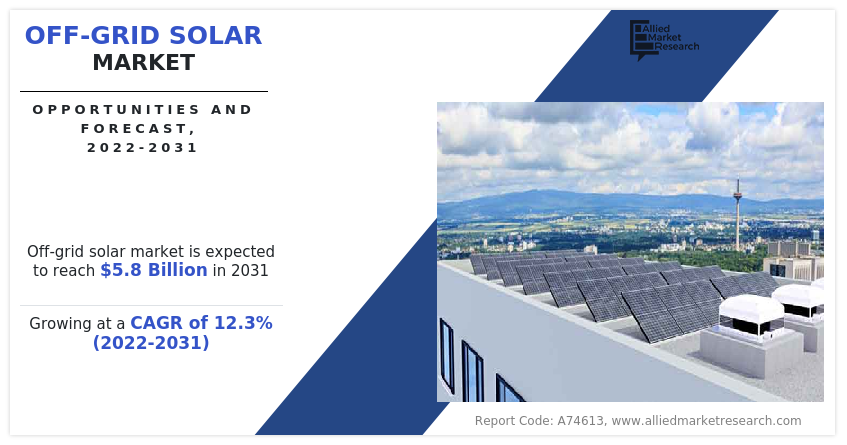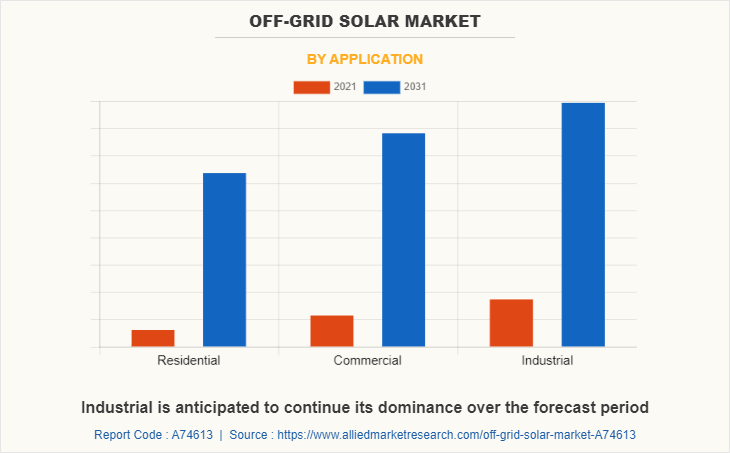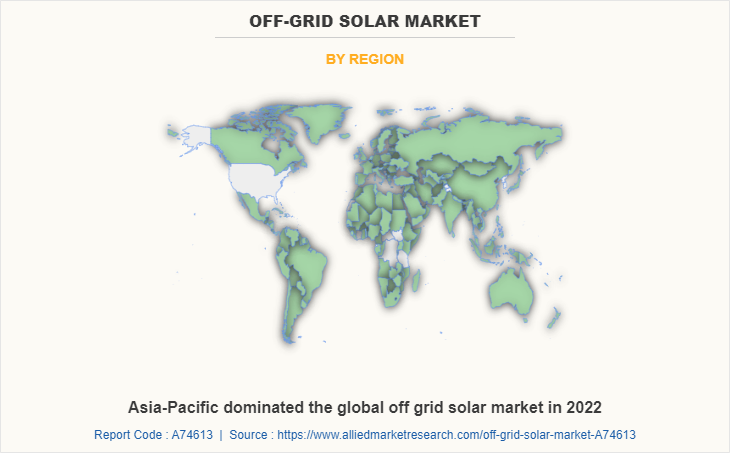OFF-Grid Solar Market Research, 2031
The global off-grid solar market size was valued at $1.9 billion in 2021, and is projected to reach $5.8 billion by 2031, growing at a CAGR of 12.3% from 2022 to 2031. Off-grid solar refers to a system that generates electricity using solar panel and operates independently of the traditional electrical grid.

It is designed to provide electricity to homes, businesses, or other structures that are not connected to a centralized power distribution network. The major parts of an off-grid solar system include solar panels, batteries, charge controllers, and inverters. Solar panels convert sunlight into electricity, which is then stored in batteries for use at some point of durations when there is no sunlight available. The charge controllers regulates the charging and discharging of the batteries, making sure of their longevity. The inverter converts the direct current (DC) electricity from the batteries into alternating contemporary (AC) electrical energy that can be used to power household home equipment and devices.
The market for off-grid solar is influenced with the increasing demand for off-grid solar systems as a realistic and sustainable solution for energy access and rural electrification. Off-grid solar structures have indeed been less costly due to declining costs of solar photovoltaic (PV) technology. These structures eliminate the need for widespread grid infrastructure and associated transmission and distribution costs, making them a reasonably-priced alternative for remote areas. The development of modern off-grid solar technologies, such as expanded photovoltaic (PV) panels , electricity storage systems, and environmentally friendly appliances, has contributed to the expansion of the off-grid solar market. These developments have made off-grid structures more efficient and reliable. These consist of monetary incentives, tax breaks, subsidies, and regulatory frameworks that encourage the deployment of off-grid solar technologies systems. Off-grid solar technologies structures offer an easy and renewable energy source, decreasing dependence on fossil fuels and minimizing greenhouse gas emissions. The off-grid solar technologies options turn to be an appealing alternative for assembly energy needs in a sustainable manner. The off-grid solar market growth is expected to continue growing as technological advancements continue, costs decrease further, and supportive policies and initiatives expand globally.
Affordability continues to be a significant barrier to the widespread adoption and growth of the off-grid solar market. While off-grid solar systems offer a clean and reliable source of electricity for remote and underserved areas, the upfront costs associated with purchasing and installing these systems can be a challenge for many individuals and communities. The price of solar panels, batteries, inverters, charge controllers, and other elements needed for off-grid solar systems can be substantial. These prices can be a significant barrier, especially for individuals and groups with constrained financial resources. In addition to equipment costs, there are charges related to the installation of off-grid solar systems. These might also consist of labor costs, transportation fees for the equipment, and any integral infrastructure modifications. These costs can in addition extend the usual upfront investment required. In some cases, potential consumers can also not be aware of the benefits and long-term price financial savings associated with off-grid solar systems. This lack of understanding can lead to an understanding that the initial prices are too high, discouraging its adoption and further hampering the off-grid solar market share revenue growth.
There is a rising demand for clean power which is expected to create substantial possibilities for the off-grid solar market expansion. These systems commonly consist of solar energy panels, batteries for electricity storage, and inverters to convert the captured power into usable electricity. Off-grid solar presents a sustainable and environmentally friendly alternative to common strength sources like coal and oil. Solar energy is a renewable resource that produces electricity without generating greenhouse gas emissions or contributing to air pollution. By opting for off-grid solar systems, individuals and groups can minimize their carbon footprint and contribute to mitigating climate change. The cost of solar panels and associated equipment has notably lowered in recent years, making off-grid solar energy solutions more affordable. In addition, off-grid solar energy eliminates the need for costly grid infrastructure, which is specifically recommended in remote areas. Therefore, off-grid solar systems can offer cost-effective electricity generation and reduce dependence on costly fossil fuels. These are the major factors projected to offer growth opportunities for the market players during the forecast period.
The key players profiled in this report include ABB Ltd., Schneider Electric SE, Canadian Solar, Engie, SMA Solar Technology ag, Jinko Solar Holding Co. Ltd, SunPower Corporation, Delta Electronics, Greenlight Plant, and Hanwha Group. Investment and agreement are common strategies followed by major market players. For instance, in November 2022, LONGi Solar Technology Co., Ltd. announced the delivery completion of 406MW of its bifacial PV panels Hi-MO 5, for the Solar plant developed by PowerChina SEPCO III for Saudi Arabia’s Red Sea Solar PV Project. The Red Sea Project includes 400MW of solar PV and is the world’s largest off-grid energy storage project.
The off-grid solar market is segmented on the basis of application and region. By application, the market is classified into residential, commercial, and industrial. By region, the market is analyzed across North America, Europe, Asia-Pacific, and LAMEA.

By application, the industrial sub-segment dominated the market in 2022. Off-grid solar refers to the use of solar power installations for commercial purposes. In addition, the industrial sector places a lot of emphasis on offering dependable and environmentally friendly electrical solutions for businesses that have no connection into the main power grid. Solar power is a clean and abundant energy source that can significantly lower operational costs over the long term. Furthermore, industries in remote areas or regions with unreliable grid infrastructure can achieve energy independence by utilizing off-grid solar solutions. This ensures a continuous and uninterrupted power supply, minimizing downtime, and increasing productivity. The goal of various sectors is to lower their carbon footprint by implementing sustainable methods. Off-grid solar power systems offer a clean and sustainable energy source, enabling businesses to achieve sustainability objectives and conform to environmental standards. These are predicted to be the major factors affecting the off-grid solar market forecast period.

By region, Asia-Pacific dominated the global market in 2022. The Asia-Pacific off-grid solar panel industry has grown as more isolated and rural regions turn to clean and dependable energy sources. Off-grid solar systems offer a sustainable and affordable option by supplying power to families and communities that are not linked to the main electrical grid. Therefore, many places in Asia-Pacific struggle to have access to dependable energy, especially in rural and isolated locations. Off-grid solar options give these underprivileged areas a practical way to satisfy their energy demands. Through a variety of laws, incentives, and subsidies, governments across the region are aggressively supporting renewable energy options, including off-grid solar. The adoption of renewable energy technology is encouraged by these policies. Off-grid solar systems are becoming more accessible and economically viable owing to the reducing cost of solar panels and related equipment over time. Off-grid solar is now a competitive alternative to conventional fossil fuel-based options due to this cost decrease. Extreme weather conditions and increasing sea levels brought on by climate change are particularly dangerous for the Asia-Pacific region.
Impact of COVID-19 on the Global Off-Grid Solar Industry
- The COVID-19 pandemic has had a significant impact on the off grid solar market. The off-grid solar market heavily relies on global supply chains for components and materials. The pandemic caused disruptions in manufacturing, transportation, and logistics, leading to delays in the production and delivery of solar products. This created challenges for companies in meeting customer demand and project timelines.
- The economic impact of the pandemic affected access to financing for off-grid solar projects. Many investors and financial institutions became cautious, leading to a decline in funding availability. This affected the growth of the off-grid solar sector, particularly in emerging markets where access to finance is already a challenge.
- Off-grid solar systems demonstrated their resilience during the pandemic. They provided reliable electricity in areas where grid power was disrupted or unreliable. This resilience and adaptability helped maintain critical services and support healthcare facilities, vaccine storage, and telemedicine initiatives.
- The pandemic and subsequent lockdown measures led to a surge in energy demand as people spent more time at home. Off-grid solar systems offered a reliable and sustainable energy solution for those without access to grid electricity, leading to increased interest and demand for off-grid solar products. On-site installations and maintenance activities have been affected, hindering the growth of the off-grid solar market during the pandemic.
Key Benefits For Stakeholders
- This report provides a quantitative analysis of the market segments, current trends, estimations, and dynamics of the off-grid solar market analysis from 2021 to 2031 to identify the prevailing off-grid solar market opportunities.
- The market research is offered along with information related to key drivers, restraints, and opportunities.
- Porter's five forces analysis highlights the potency of buyers and suppliers to enable stakeholders make profit-oriented business decisions and strengthen their supplier-buyer network.
- In-depth analysis of the off-grid solar market segmentation assists to determine the prevailing market opportunities.
- Major countries in each region are mapped according to their revenue contribution to the global market.
- Market player positioning facilitates benchmarking and provides a clear understanding of the present position of the market players.
- The report includes the analysis of the regional as well as global off-grid solar market trends, key players, market segments, application areas, and market growth strategies.
OFF-Grid Solar Market Report Highlights
| Aspects | Details |
| Market Size By 2031 | USD 5.8 billion |
| Growth Rate | CAGR of 12.3% |
| Forecast period | 2021 - 2031 |
| Report Pages | 260 |
| By Application |
|
| By Region |
|
| Key Market Players | greenlight plant, ABB Ltd., Engie, Hanwha Group, SunPower Corporation, Delta Electronics, Jinko Solar Holding Co. Ltd, Canadian Solar, SMA Solar Technology ag, Schneider Electric SE |
The rising demand for off-grid solar systems offer a viable solution to provide electricity access in remote and underserved areas where grid extension is not feasible. This market opportunity is significant in developing countries where millions of people still lack access to electricity, which is estimated to generate excellent opportunities in the off grid solar market.
The major growth strategies adopted by off grid solar market players are investment and agreement.
Europe will provide more business opportunities for the global off grid solar market in the future.
ABB Ltd., Schneider Electric SE, Canadian Solar, Engie, SMA Solar Technology ag, Jinko Solar Holding Co. Ltd, SunPower Corporation, Delta Electronics, Greenlight Plant, and Hanwha Group are the major players in the off grid solar market.
The industrial sub-segment of the application acquired the maximum share of the global off grid solar market in 2022.
The report provides an extensive qualitative and quantitative analysis of the current trends and future estimations of the global off grid solar market from 2022 to 2032 to determine the prevailing opportunities.
The market for off grid solar is influenced by the increasing concerns about climate change and as environmental sustainability continue to rise there is an increasing demand for clean energy solutions. Off-grid solar provides an environmentally friendly alternative to fossil fuel-based power sources, which is estimated to drive the adoption of off grid solar.
The off-grid solar provides a unique opportunity to bring electricity to remote and underserved areas that are not connected to the traditional grid. It allows individuals and villages to access reliable and clean energy, enabling them to power homes, schools, healthcare facilities, and small businesses. This is anticipated to boost the off grid solar market growth in the upcoming years.
Loading Table Of Content...
Loading Research Methodology...



